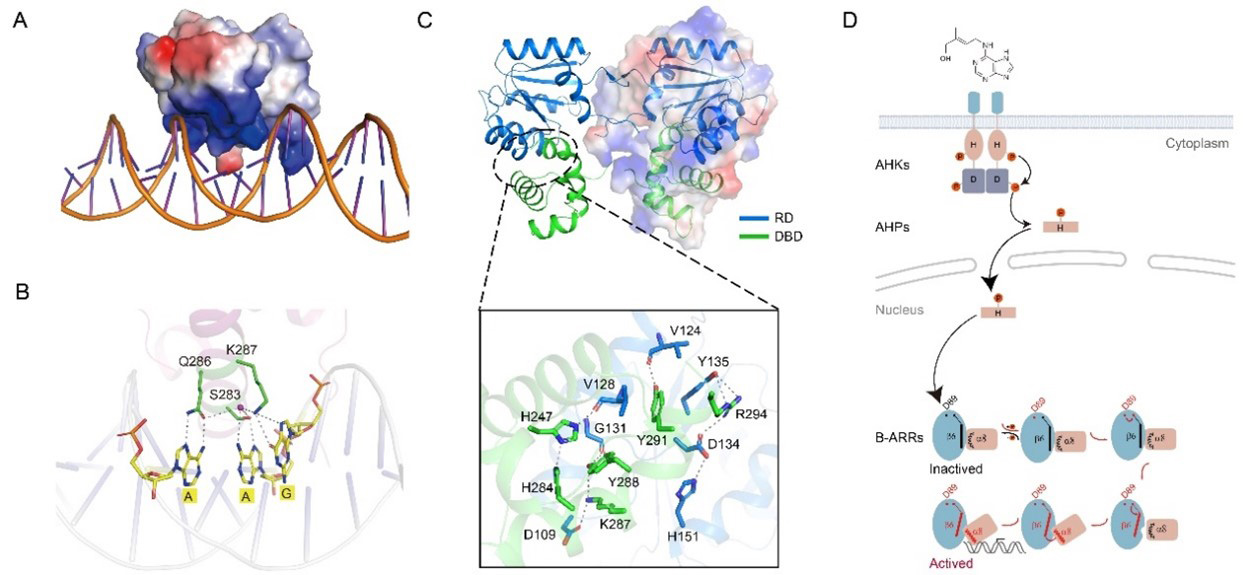A Rapid Transcriptional Switch in Response to Plant Phytohormone Cytokinin
Cytokinin is an important phytohormone that plays multiple roles in plant growth and development, including maintaining meristematic tissues, promoting vascular tissue differentiation, regulating leaf senescence, and promoting shoot regeneration. Previous studies have suggested that cytokinin signaling is similar to bacterial two-component systems, transmitting signals from the cell membrane to the nucleus through a phosphorelay system, thereby activating specific downstream gene expression. The ultimate target of this phosphorelay system is a group of transcription factors named B-type Arabidopsis Response Regulators (B-ARRs), which consist of a conserved N-terminal receiver domain (RD), a middle DNA binding domain (DBD), and a C-terminal transactivation domain. Twenty years ago, researchers discovered that when cytokinin is recognized by cell surface receptors, the signal is relayed through specific histidine residues on histidine phosphotransfer proteins (AHPs), which further transfer the phosphate group to aspartate residues on the RD of B-ARRs, rapidly activating the transcriptional response to cytokinin. However, the precise molecular mechanism of this regulatory process remains unclear.
In a study published in PNAS on Jan 10, 2024, two groups led by WANG Jia-Wei and ZHANG Peng respectively at the CAS Center for Excellence in Molecular Plant Sciences now addressed this long-standing question by solving the structure of B-ARR proteins. They first elucidated the crystal structures of the RD-DBD (ARR1RD-DBD) from the model plant Arabidopsis thaliana B-ARR member ARR1, as well as the ARR1DBD-DNA complex. Analysis of the ARR1DBD-DNA complex revealed the structural basis for ARR1's specific recognition of the GAT trinucleotide sequence (Figure 1A and 1B). By comparing the structures of ARR1RD-DBD and ARR1DBD-DNA, further insights were gained into the closed conformation of unphosphorylated ARR1RD-DBD, with extensive contacts between RD and DBD. In vitro and in vivo functional experiments demonstrated that phosphorylation of RD weakened its interaction with DBD, resulting in conformational changes in DBD that allowed it to bind to target DNA and activate downstream gene expression (Figure 1C and 1D). In sum, this work not only provides insights into the molecular mechanisms of cytokinin-induced transcriptional activation but also shed light on how the two-component system orchestrates gene transcription through phosphorylation relay in eukaryotes.
Dr. ZHOU Chuan-Miao from the CAS Center for Excellence in Molecular Plant Sciences and Dr. LI Jian-Xu from the Chenshan Research Center are co-first authors of this paper. Dr. WANG Jia-Wei and Dr. ZHANG Peng are the corresponding authors. Dr. ZHANG Tian-Qi, Dr. XU Zhou-Geng, and MA Miao-Lian also participated in this work. This research was supported by the National Natural Science Foundation of China, the Strategic Priority Research Program of the Chinese Academy of Sciences, and New Cornerstone Science Laboratory.
Figure 1. A diagram of the working model of the molecular basis of transcriptional activation by cytokinin.
Contact:
Dr. WANG Jia-Wei, Professor; ZHANG Peng, Professor
National Key Laboratory of Plant Molecular Genetics, Center for Excellence in Molecular Plant Sciences, Chinese Academic of Sciences
